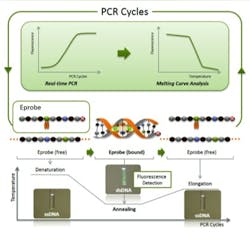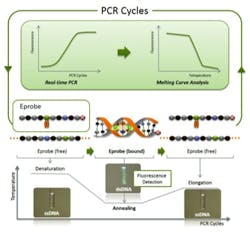Molecular fluorescent probe could enable advanced genetic testing
Researchers from the RIKEN Center for Life Science Technologies and the Preventive Medicine & Diagnosis Innovation Program (both in Wako, Japan), as well as K.K.DNAFORM (Yokohama City, Japan), have developed a new molecular fluorescent probe for polymerase chain reaction (PCR) DNA amplification techniques and DNA analysis in hybridization experiments. The technology, dubbed Eprobe, will enable development of new, advanced assays for DNA-based genetic testing and help to bring the benefits of genome-wide sequencing studies to patients in the clinic.
Related: Unraveling the basis of disease with NIR molecular probes
Eprobes are short DNA oligonucleotides labeled with two fluorescent dye moieties attached to the same nucleotide. During the DNA amplification reaction, the probes bind to the newly synthesized DNA fragments, emitting a strong fluorescence signal upon binding, which enables researchers to monitor the reaction in real time. In the study, the researchers used Eprobes for the detection of genetic variations in the human EGFR and KRAS tumor genes by combining real-time PCR with a hybridization technique. They show that Eprobes provide decisive advantages over commonly used hybridization probes because of their unique background signal reduction, enhanced DNA-binding affinity, and very low false-positives rate.
âEprobe enables real-time PCR methods, which are gaining importance for medical diagnostics and many life science applications, because they can provide quantitative results and increased reliability as compared to standard PCR methods,â explains Kengo Usui, the leader of the Genetic Diagnosis Technology Unit at the RIKEN Center for Life Science Technologies.
Takeshi Hanami, first author of the paper, explains that the new technology will enable the development of advanced assay formats for simultaneous detection of multiple target genes, which could be useful in tumor diagnosis.
The work appears in the journal PLoS ONE; for more information, please visit http://dx.plos.org/10.1371/journal.pone.0070942.
-----
Follow us on Twitter, 'like' us on Facebook, and join our group on LinkedIn
Subscribe now to BioOptics World magazine; it's free!

